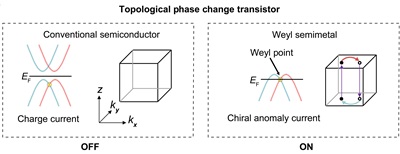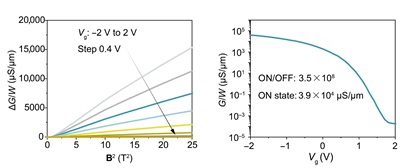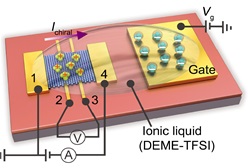Weyl semiconductor enables highperformance topological transistors
Field-effect transistors—which use an electric field to control the current in semiconductors—are the building blocks of integrated circuits. State-of-the-art silicon transistors are mainly based on the charge transport mechanism, which results in unavoidable phonon scattering and high heat dissipation. As transistor density increases, high power consumption in electronic chips may compromise circuit performance and reliability. Researchers have investigated the spin and valley of electrons as information carriers for low-loss transport. However, these spin/valley transistors cannot meet the requirements for high- performance, low-power transistors due to their relatively small ON/OFF ratio (101 to 103) and low drive current.
Aiming to overcome these constraints, Prof. Chai Yang, Core Member of the Research Institute for Intelligent Wearable Systems (RI-IWEAR), led his team in the successful development of Topological Phase Change Transistors (TPCTs) based on Tellurium (Te)—a Weyl semiconductor. The team’s technological breakthrough was recently published in Science Advances.
The Te Weyl semiconductors have a band gap similar to a conventional semiconductor, but with Weyl points in the vicinity of valence/conduction bands. The Te channel can therefore be switched between these two topological phases by electrostatic modulation with high double-layer capacitance. The Fermi level of the Weyl semiconductor can be positioned within the band gap or close to the Weyl point at different gate voltages. As the Fermi level of Te moves into the band gap, the Te channel is turned to the OFF state with the conventional semiconductor phase, exhibiting very low conductance and resulting in low static power consumption. When the Fermi level approaches the Weyl point, the Te channel is switched to the ON state with the Weyl topological phase, exhibiting an ultrahigh ON-state conductance with low-loss topological current.
To verify this operating mechanism, the team performed different control experiments (on angle-dependent negative magnetoresistance, the planar Hall effect, and nonlocal transport). These experiments strongly supported the observation of topological current.



Science Advances: https://www.science.org/doi/10.1126/sciadv.abn3837
The research team developed TPCTs using Te flakes with a thickness of approximately 10 nanometers as the channel material. TPCTs with the Te Weyl semiconductor exhibited high performance with operating voltage less than 2 V. The ON/OFF ratio was as high as 108, and the ON-state conductance reached 39 mS/μm. Therefore, this new type of transistor opens the way for field-effect transistors with low-power consumption.



